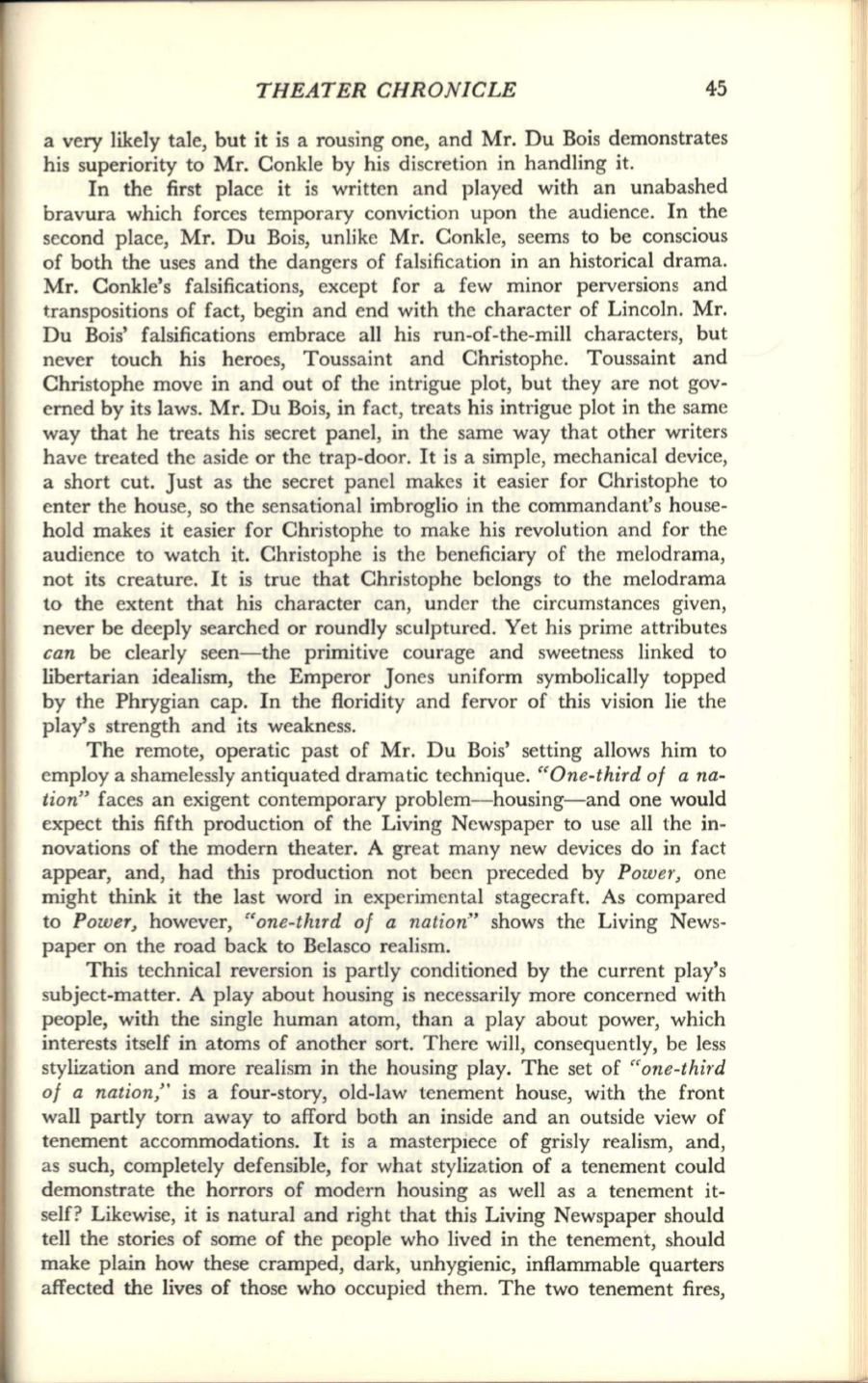
THEATER CHRONICLE
45
a very likely tale, but it is a rousing one, and Mr. Du Bois demonstrates
his superiority to Mr. Conkle by his discretion in handling it.
In the first place it is written and played with an unabashed
bravura which forces temporary conviction upon the audience. In the
second place, Mr. Du Bois, unlike Mr. Conkle, seems to be conscious
of both the uses and the dangers of falsification in an historical drama.
Mr. Conkle's falsifications, except for a few minor perversions and
transpositions of fact, begin and end with the character of Lincoln. Mr.
Du Bois' falsifications embrace all his run-of-the-mill characters, but
never touch his heroes, Toussaint and Christophe. Toussaint and
Christophe move in and out of the intrigue plot, but they are not gov–
erned by its laws. Mr. Du Bois, in fact, treats his intrigue plot in the same
way that he treats his secret panel, in the same way that other writers
have treated the aside or the trap-door. It is a simple, mechanical device,
a short cut. Just as the secret panel makes it easier for Christophe to
enter the house, so the sensational imbroglio in the commandant's house–
hold makes it easier for Christophe to make his revolution and for the
audience to watch it. Christophe is the beneficiary of the melodrama,
not its creature. It is true that Christophe belongs to the melodrama
to the extent that his character can, under the circumstances given,
never be deeply searched or roundly sculptured. Yet his prime attributes
can
be clearly seen-the primitive courage and sweetness linked to
libertarian idealism, the Emperor Jones uniform symbolically topped
by the Phrygian cap. In the floridity and fervor of this vision lie the
play's strength and its weakness.
The remote, operatic past of Mr. Du Bois' setting allows him to
employ a shamelessly antiquated dramatic technique.
((One-third of a na–
tion"
faces an exigent contemporary problem-housing-and one would
expect this fifth production of the Living Newspaper to use all the in–
novations of the modern theater. A great many new devices do in fact
appear, and, had this production not been preceded by
Power)
one
might think it the last word in experimental stagecraft. As compared
to
Power)
however,
({one-thIrd of a nation""
shows the Living News–
paper on the road back to Belasco realism.
This technical reversion is partly conditioned by the current play's
subject-matter. A play about housing is necessarily more concerned with
people, with the single human atom, than a play about power, which
interests itself in atoms of another sort. There will, consequently, be less
stylization and more realism in the housing play. The set of
((one-third
of a nation/'
is a four-story, old-law tenement house, with the front
wall partly torn away to afford both an inside and an outside view of
tenement accommodations. It is a masterpiece of grisly realism, and,
as such, completely defensible, for what stylization of a tenement could
demonstrate the horrors of modern housing as well as a tenement it–
self? Likewise, it is natural and right that this Living Newspaper should
tell the stories of some of the people who lived in the tenement, should
make plain how these cramped, dark, unhygienic, inflammable quarters
affected the lives of those who occupied them. The two tenement fires,


